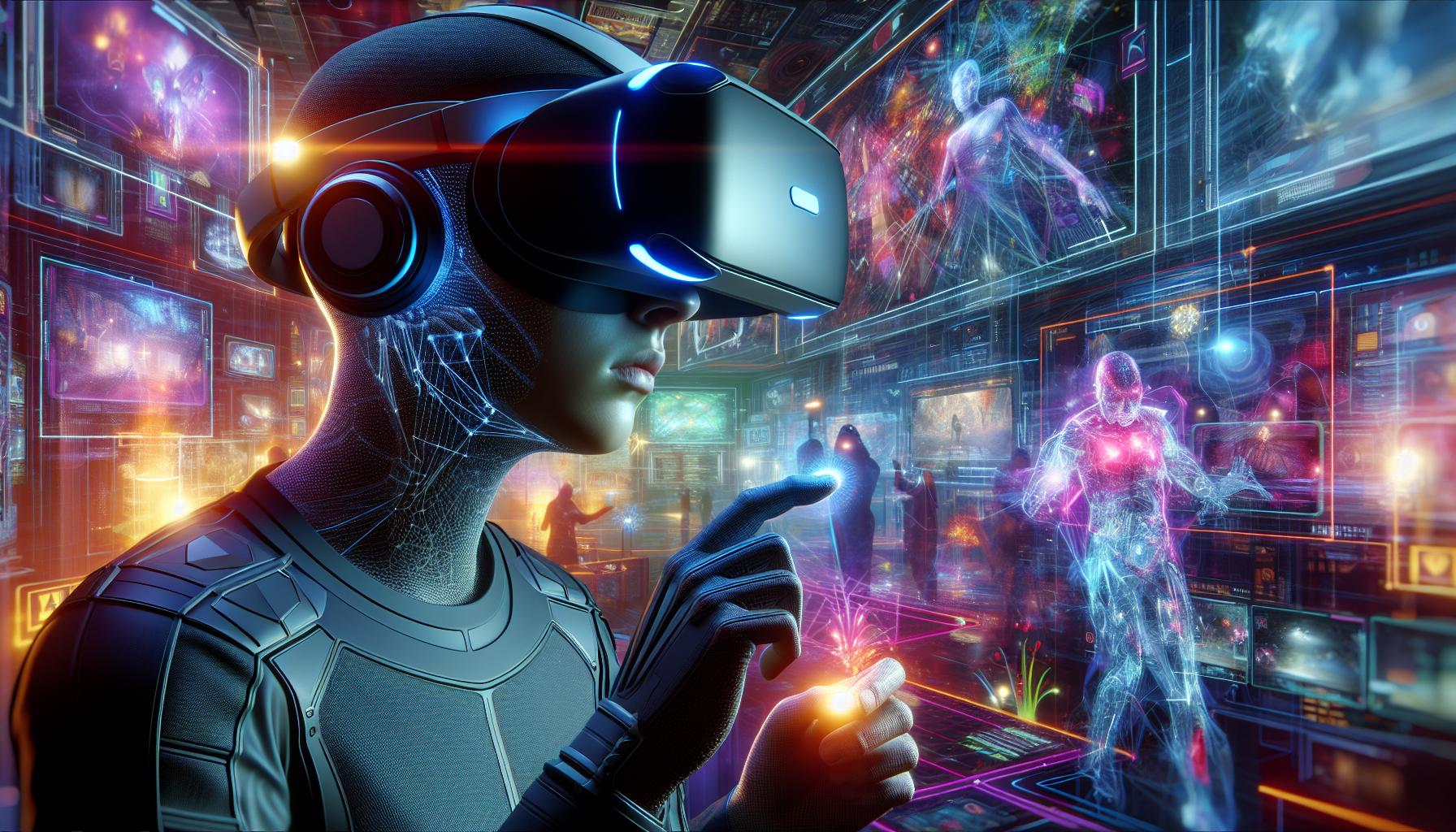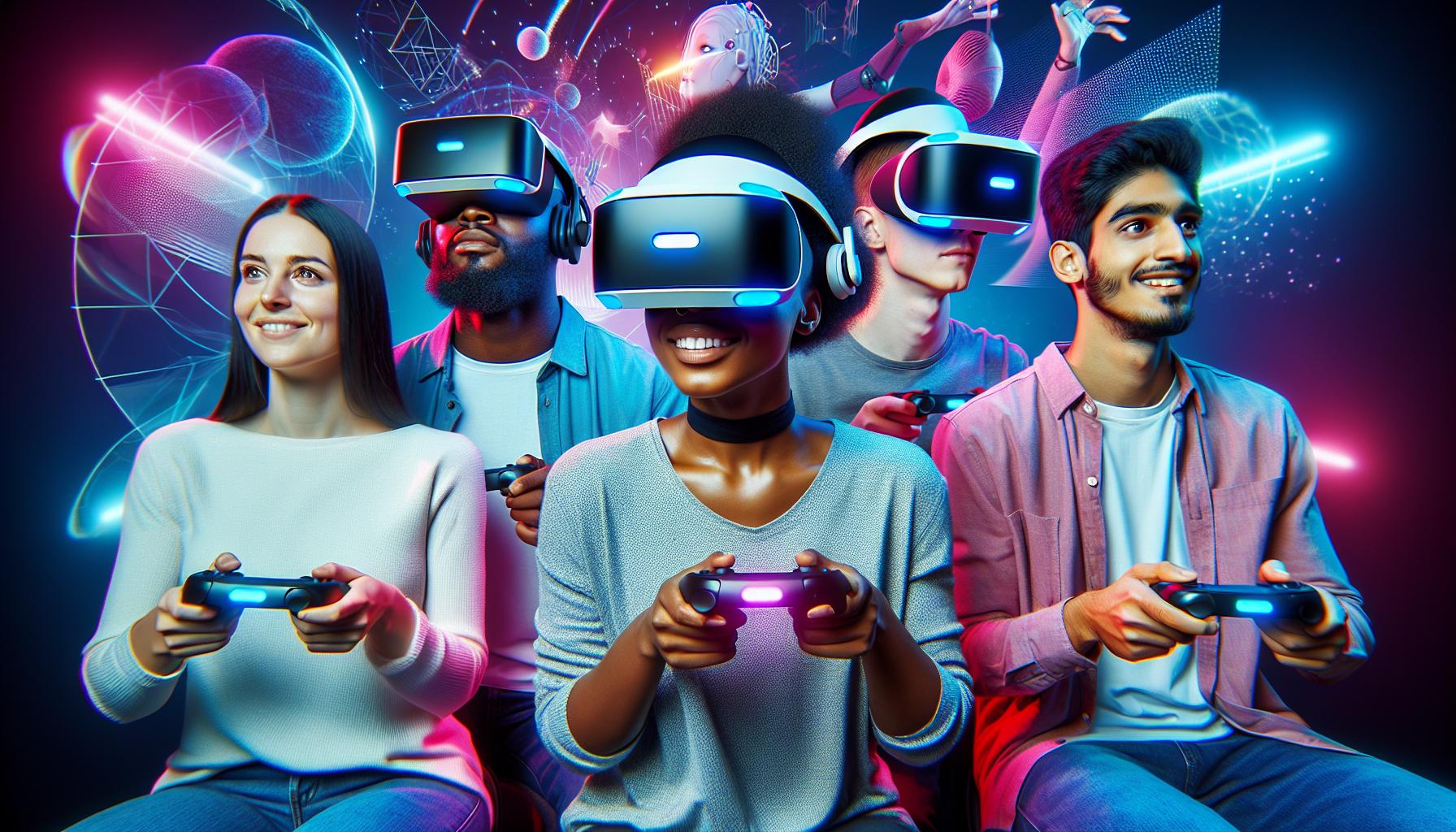Key Takeaways
- Transformative Potential: Virtual reality (VR) is redefining how we interact with entertainment, education, and social spaces, merging digital and physical worlds.
- Key Technologies: Advancements in hardware (like headsets and sensors) and software (such as gaming and educational applications) are driving immersive user experiences.
- Broad Applications: VR is being utilized across various fields including gaming, education, healthcare training, social interactions, and e-commerce, enhancing engagement and learning.
- Emerging Trends: Future developments include improved graphics, wireless technology, AI personalization, and integration with augmented reality (AR) for hybrid experiences.
- Challenges Ahead: Technical limitations, particularly high costs and battery life issues, along with user adoption barriers such as discomfort and social stigma, pose obstacles to widespread VR acceptance.
- Ethical and Accessibility Considerations: As VR evolves, attention to ethical implications and accessibility for individuals with disabilities will be crucial in shaping responsible use and broader acceptance.
Virtual reality is no longer just a novelty; it’s rapidly transforming how people experience entertainment, education, and even social interactions. As technology advances, the immersive potential of VR continues to expand, promising a future where the lines between the digital and physical worlds blur. With innovations in hardware and software, users can expect more realistic environments that engage the senses like never before.
The future of virtual reality holds exciting possibilities, from enhanced gaming experiences to virtual classrooms that can transport students to historical events. As industries adopt VR for training and collaboration, it’s clear that this technology will play a pivotal role in shaping how society interacts with information and each other. The journey into this brave new world is just beginning, and the implications are vast and profound.
Future of Virtual Reality
Virtual reality (VR) immerses users in computer-generated environments that simulate real or imagined experiences. VR technology creates a sense of presence in a virtual world through headsets and motion-tracking devices. This immersion transforms how individuals interact with digital content across various sectors.
Key Components of Virtual Reality
- Hardware: VR systems utilize headsets, sensors, and controllers. Headsets such as the Oculus Quest, HTC Vive, and Valve Index deliver visuals, while sensors track movements, enhancing interactivity.
- Software: VR applications range from gaming titles to educational programs. Software platforms operate various environments, delivering unique experiences tailored to user engagement.
- Interactivity: Users engage with virtual environments through gestures, voice commands, or physical movements. This interactivity fosters a deeper connection between the user and the simulated world.
Applications of Virtual Reality
- Gaming: VR gaming offers immersive experiences that elevate gameplay. Popular titles include Beat Saber and Half-Life: Alyx, showcasing innovative mechanics.
- Education: Virtual classrooms enable interactive learning experiences. Tools like Google Expeditions help students explore historical sites or anatomical models.
- Training: Industries leverage VR for training simulations. Organizations utilize VR for scenarios like medical procedures, emergency response, and flight simulations.
- Social Interaction: VR allows people to connect in virtual spaces. Platforms like VRChat and AltspaceVR facilitate social gatherings in immersive settings.
- Advancements in Technology: Improvements in graphics, hardware ergonomics, and wireless capabilities enhance the user experience. Continuous development in artificial intelligence (AI) will also make virtual environments more responsive and realistic.
- Integration in Daily Life: VR’s adoption in remote work and e-commerce indicates broader acceptance. Virtual meetings and retail experiences may become more prevalent, altering how people manage professional and personal activities.
- Ethical Considerations: As VR technology evolves, ethical implications arise. Issues of privacy, data security, and psychological effects on users must be addressed, ensuring responsible use.
- Expanding Accessibility: Efforts to make VR more inclusive would improve access for individuals with disabilities. Innovations aimed at accommodating various needs may broaden the user base.
The ongoing advancements in virtual reality demonstrate its potential to reshape engagement with digital content drastically, indicating a transformative future ahead.
Current State of Virtual Reality

The current state of virtual reality (VR) showcases significant advancements and widespread applications across multiple sectors. Technologies continue to evolve, pushing boundaries in immersion and interactivity, leading to diverse user experiences.
Key Technologies Driving VR
- Headsets: Devices like the Meta Quest 3 and HTC Vive XR Elite offer high-resolution displays and enhanced tracking. These headsets enable users to engage with detailed virtual environments.
- Sensors: Motion sensors and eye-tracking technology improve user interaction. These technologies facilitate a more intuitive experience by responding to users’ movements and gaze.
- Software Platforms: Platforms such as Unity and Unreal Engine allow developers to create complex VR experiences. These tools provide the foundation for gaming, training simulations, and educational applications.
- Networking: The advent of 5G technology enhances data transmission speeds. This improvement supports smoother experiences in multiplayer VR environments, connecting users in real-time.
- Artificial Intelligence: AI integration personalizes user interactions and adaptive learning experiences. Algorithms assess user behavior to create tailored environments and challenges.
- Gaming: VR gaming titles like “Beat Saber” and “Half-Life: Alyx” offer engaging, immersive experiences. These games utilize VR technology to heighten excitement and interactivity.
- Education: VR applications in education, such as “engage” platforms, provide immersive learning environments. These platforms allow students to explore historical events or conduct scientific experiments in simulated settings.
- Training Simulations: Industries like healthcare and aviation utilize VR for training purposes. Medical professionals undergo surgery simulations while pilots practice in virtual cockpits, reducing risk and enhancing skills.
- Social Interaction: Platforms like VRChat facilitate social connections in virtual spaces. Users engage in conversations and activities, fostering community in an immersive environment.
- E-commerce: Retailers use VR to create virtual showrooms. Customers experience products in 3D, enabling informed purchasing decisions without physical interaction.
Future of Virtual Reality

The future of virtual reality (VR) holds vast potential, shaped by emerging trends and its impact on various industries. Continuous advancements promise to redefine user interactions with digital environments.
Emerging Trends
- Enhanced Graphics: Development in graphic rendering techniques like ray tracing leads to more realistic environments.
- Ergonomic Hardware: Innovations in headset design improve comfort, reducing fatigue and increasing usage duration.
- Wireless Technology: Advancements in wireless capabilities eliminate cables, promoting freedom of movement during VR experiences.
- Social Integration: Virtual reality platforms increasingly incorporate social features, facilitating interaction among users in rich, immersive settings.
- Augmented Reality (AR) Convergence: Integration with AR technology allows for hybrid experiences, blending real and virtual elements seamlessly.
- AI Personalization: AI enhances user experiences by adapting content and interactions based on individual preferences and behaviors.
- Education: VR transforms learning environments, enabling immersive simulations that enhance retention and engagement.
- Healthcare: Medical training utilizes VR for realistic simulations, improving skills without risk to patients.
- Entertainment: Interactive storytelling and immersive gaming experiences reshape how audiences engage with content.
- Real Estate: Virtual tours allow potential buyers to explore properties remotely, streamlining the buying process.
- Manufacturing: VR aids in design and prototyping, allowing engineers to visualize and modify products before physical creation.
- Tourism: Virtual travel experiences provide users with a taste of destinations, influencing future travel decisions.
Challenges Facing Virtual Reality

Virtual reality faces multiple challenges that could affect its future growth and acceptance. These challenges encompass technical limitations and user adoption barriers.
Technical Limitations
Technical limitations hinder the full potential of VR technology. Hardware constraints include the need for high processing power, resulting in expensive systems. Limited battery life on devices like headsets restricts prolonged use. Latency issues can cause motion sickness and disrupt user experiences during interactions.
Software obstacles also impact VR. Developing high-quality, responsive applications requires substantial resources, including skilled developers and extensive testing. Compatibility issues across different platforms can frustrate users and fragment the VR ecosystem.
User Adoption Barriers
User adoption barriers still exist in the widespread acceptance of VR. Cost remains a significant obstacle, with high prices for quality headsets and accessories deterring potential users. Many individuals express concerns about discomfort during long sessions, while social stigma surrounding VR use can discourage people from trying it.
Limited understanding of VR’s advantages contributes to low adoption rates. Educational outreach and marketing efforts often fail to demonstrate how VR can enhance everyday activities and professional training. Additionally, accessibility needs for individuals with disabilities require attention to ensure inclusive experiences, which might not be fully addressed in current offerings.
Future of Entertainment, Education, And Social Interaction
The future of virtual reality is bright and full of potential. As technology continues to advance, users can expect even more immersive and interactive experiences. The integration of AI and the convergence with augmented reality will further enhance how individuals engage with digital content.
While challenges remain, such as technical limitations and user adoption barriers, ongoing innovations are paving the way for broader acceptance. The transformative impact of VR across various sectors highlights its importance in shaping the future of entertainment, education, and social interaction.
As VR evolves, its ability to create meaningful connections and experiences will undoubtedly redefine how people interact with technology and each other. The journey ahead promises exciting developments that will continue to captivate and inspire users worldwide.